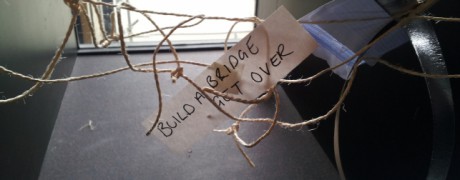Welcome to the Engine House Tool Kit – an array of instruments for your virtual artist’s utility belt as you grapple with the forces of inter-disciplinary work.
New tools will be added quarterly as part of the practical outcome from David’s Digest, so let us know what you think: and if you have tools to share please let us know via the Contact page.
Tool #1: Share Your Blueprints
You have a site. You have a set of artists. You have excitement, energy and enthusiasm. Everything is lined up and ready to go. You green light your way full pelt into the creation of ideas and concepts and starting points and then voices emerge…
That’s not what I meant.
That’s not what I said when I said that.
I thought that was what we’re doing.
I can’t move forward without doing that first.
That’s not how my process works.
Why isn’t there more coffee?
And so on.
This first tool can kick in before or as part of exploring potential collaborations or collaborators, quickly kicking to one side the assumption that as artists we all speak a common language.
We don’t.
We might have common philosophies and interests. But language? Vocabularies? Don’t count on it.
So when you’re under starter’s orders, try applying the following steps:
Step 1: Each artist is issued with a piece of A3 paper divided into five columns
This exercise is about mapping out the general shape of your process – the rough journey you take when creating your work. Although every project we do introduces a particular shape of work, that doesn’t matter too much – this is about identifying our working habits.
Step 2: Each artist will be given 5 minutes to respond in each column by writing left to right across the columns
Column 1: Beginnings
Where does your work start? What’s the spark? What / who are your influences? What kick-starts your imagination? What’s the creative stimulus?
Column 2: Next Steps
What do you do next? Make? Plan? Sketch? Think? Make the whole thing? Where and how does this work take place?
Column 3: First Go
What comprises a ‘first draft’ for you? Is there one? What don’t you do or leave out? What are the questions or gaps at this stage? What is it (a score, a script, lyrics, pictures, a combination of these)? Do you need other people?
Column 4: Reflecting
On whom or how do you test this work out? How do you know it’s doing the job? Do you share it? Take time away from it? Whose feedback or guidance do you take on board, if any?
Column 5: Vocabulary
What would you consider your technical vocabulary to be? What words or phrases are used to help navigate you or others through the work (i.e. for playwrights it might be story, plot, character, dialogue; for musicians it might be key signatures, time signatures, phrases, recitatives, codas, orchestration)?
Step 3: Share and Talk
Spend 10 minutes sharing your working habits and vocabulary. Talk out loud to others through what you’ve drawn (this is important) and respond to any questions. Consider:
- what are the differences or similarities between artists?
- how might these be useful, and where might they cause problems to overcome?
Step 4: Make a Record
What’s been discovered in this artistic team that might be useful, challenging, or could push your work in a new direction? What have you learned that you might apply to your own process in the future? Bear in mind the tempo and rhythm of people’s work – how they think, process and move forward (or not) with choices – not just skills and techniques.
Step 5: Think Laterally
The exercise above assumes a step-by-step and fairly linear progression of practice. Beware this assumption! Whilst it’s useful to organise a process, it’s important not to let method interrupt spontaneity. So now, spend 5 minutes drawing a visual representation of your process. Be as instinctive as you can.
Step 6: What’s New?
Finish off by comparing pictures. What has this revealed about your process that you wouldn’t have discussed or shown by expressing it in a more ordered way?
Tool Rule #1: Don’t underestimate the necessity of conversation and lateral thinking around process.
